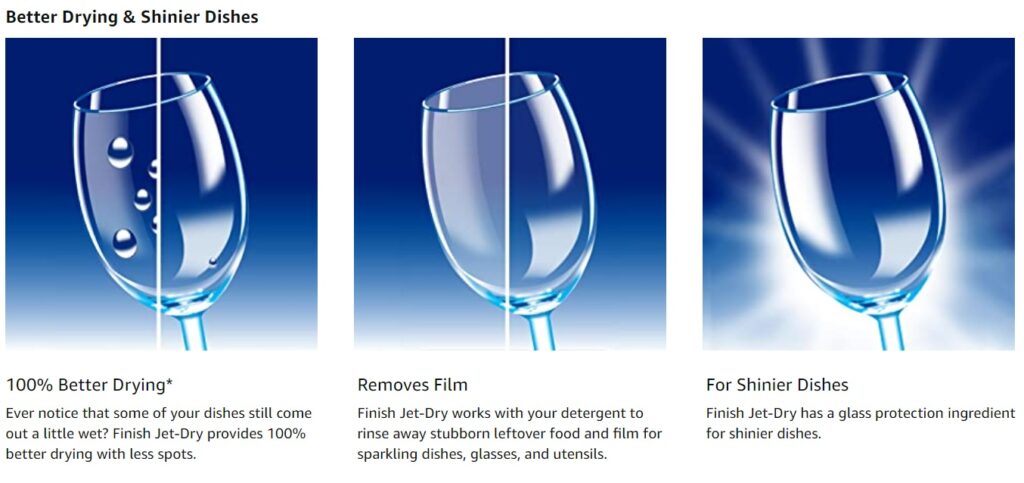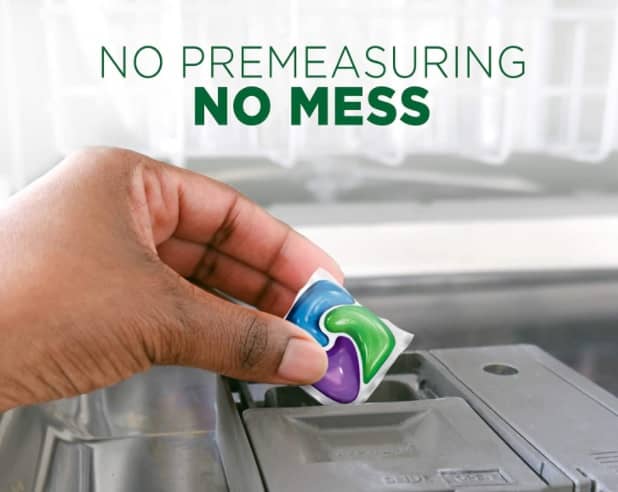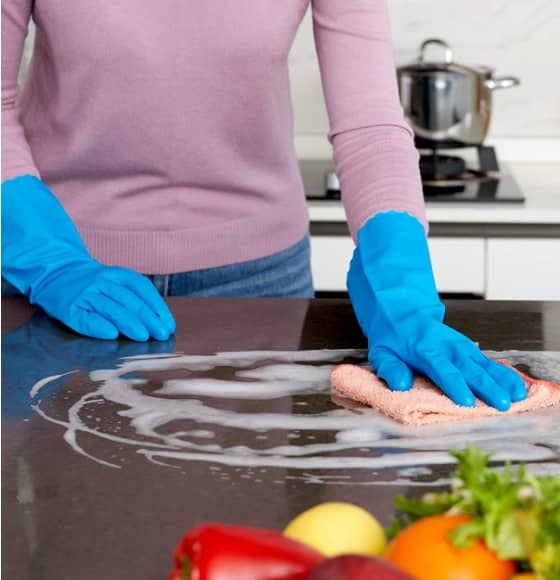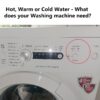What is a dishwasher rinse aid?
Or what purpose does it serve in dishwashing?
Can you skip it?
There are a lot of questions that a newbie usually has regarding a dishwasher rinse aid.
So, here in this article, we will focus on all the basics of rinsing agents.
We will also look into the safety concerns for our health and environment and the necessity of a dishwasher rinse agent.
Content:
- What is a dishwasher rinse aid?
- Advantages of a dishwasher rinse aid
- Types of Dishwasher Rinse Aid
- How does dishwasher rinse aid work?
- Why only dishwasher detergent is not enough?
- Is dishwasher rinse aid safe?
- What is a plant-based dishwasher rinse agent?
- How to pick an effective natural dishwasher rinse aid?
- What is a homemade dishwasher rinse aid?
- Does DIY dishwasher rinse aid work?
- When can I skip the dishwasher rinse aid?
- How to properly use a dishwasher rinse aid?
What is a Dishwasher Rinse Aid?
Dishwasher rinse aid, contrary to its name, has got nothing to do with rinsing dishes. Rinse aid works to remove the excess water off the dishes and aids in drying them. So dishwasher rinse aid is more like a dish drying aid.

Dishwasher rinse aid is a chemical component called surfactant. Surfactant is an agent that reduces water’s surface tension.
In a layman’s language rinse aid prevents the water from forming into droplets on your dishes after they have been washed. It instead makes the droplets spread into a thin sheet. Thus the water gets vaporized faster. This is how a rinse aid helps in drying the dishes and prevents water spotting and white films by making your glasses and plates shinier.
Clearly, in one sentence – rinse aid is the drying agent in dishwashing that helps you get shiny and spotless dishes.
Advantages of Using a Rinse Aid:

Dishwasher rinse aids are surfactants that help lessen the surface tension of water by breaking their bond. This breakdown of surface tension prevents water droplets’ formation and makes them spread into a thin sheet or layer of water.
Water droplets take more time and heat energy to evaporate while the thin layer of water evaporates quickly and easily. So at the end of your dishwasher cycle, your dishes are clean and properly dried.
Another essential thing that rinses aid does is provide perfectly shiny glassware. It majorly prevents the formation of water spots & cloudy films on the glass surface, making it spot less and bright.
It also contains the anti-redeposition agent sodium polycarboxylate, which prevents the remains and food particles from coming back on dishes and makes them washed out thoroughly.
Types Of Dishwasher Rinse Aids:
There are three types of dishwasher rinse aids available on the market.
- Single-dose units
- Gel-based rinse aids
- Powder Boosters
a. Single-dose Units or All-in-one Pacs

The single-dose units are also knowns as tablets, tabs, pacs, etc. They are tablet units intended for single use. It comes with a premeasured amount of detergent and rinse aid for one-cycle use. The single-dose units are considered more useful as compared to gels or powders. They are also easier to use for those who don’t know how to measure the right amount of dishwasher rinse aid.
b. Gel-based or Liquid Rinse Aids:
The gel-based rinse aids are the most inexpensive. Results from gels aren’t compelling enough as compared to single-dose units. But some good quality gel-based rinse aids have got impressive results.
c. Powder Boosters:

These are actually not known as rinse aid rather powder booster but the end result is same. You get sparkly dishes. These powder boosters have the sole task of improving the function of your dishwasher detergent if you live in hard water zone. As hard water leaves bad stains, these powder boosters along with your detergent make your dishes spot-less and clean.
How does Dishwasher Rinse Aid Work?
Water molecules love to hang onto each other. That’s why we usually see water droplets after washing a dish. As the water molecules do not get enough molecules to spread, they bond to each other and form the shape of a droplet.
This slows down the drying process of your dishes. Now slow drying is not necessarily a bad thing if it does not involve hard water. If the water is hard and your dishes are not drying fast, they will get white films and stains.
After buying an expensive dishwasher, dishwashing detergent, and dishwasher salt, you surely don’t want to see white filmed dishes. Here’s where the dishwasher rinse aid helps.
How does the dishwasher rinse aid help in faster drying?
Dishwasher rinse aid breaks the clingy nature of water molecules. This clingy nature is also known as surface tension and that’s why dishwasher rinse aid is also known as surfactant. The drying agent gives the water molecules something else to hang on and thus they separate. By breaking the water droplets in thin sheets dishwasher rinse aid increases the drying speed. This results in spot-less dishes.
Dishwasher rinse aids not only fasten the drying process but also helps in keeping the dirty food bits washed by the dishwasher from attaching again to the dishes. So, in a way, a dishwasher rinse aid also helps in keeping your dishes dirt and germ-free. For a detailed explanation of how a dishwasher rinse aid work read this article from Wirecutter.
Why Only Dishwasher Detergent is Not Enough?

Dishwasher detergent is also a surfactant which helps in cleaning the dishes. So, why not a dishwasher detergent alone can handle the drying process?
Well, a dishwasher detergent comes with a lot of surfactants which mainly aids in deep and tough cleaning. These surfactants act as an anti-redeposition agent to prevent dirt and grime from depositing onto the surface of the dishes.
As, dishwasher detergent has different types of surfactants that focuses on mainly cleaning the dirty dishes, it cannot do it all. That’s why we need a specialist like dishwasher rinse aid to dry the dishes and keep spots from occurring.
Is dishwasher rinse aid safe for our health and environment?
The human health and environment watchdog – EWG (Environmental Working Group) rated 19 different rinse aid products, 12 brands, 11 rinse aid companies (as of March 2021) available in the market to see if they are safe enough to use.
Among them 3 rinse aid scored “A”, 1 scored “B”, 4 scored “C”, 6 scored “D” and 5 scored “F”.
F graders and the D graders are the lowest-performing ones, that have some concerning ingredients in them such as-
the Sodium tripolyphosphate, Methylchloroisothiazolinone, Antiredeposition agent, Oxybenzone, etc.
These are in big amounts bad for both our health and environment. So the question is are you willing to use a dishwasher rinse aid even if it has some health concerns? Fortunately there are some brands that offer plant-based dishwasher rinse aids which are safe to use.
What is a Natural or Plant-based Dishwasher Rinse aid?
The natural plant-based surfactant is made with unique biodegradable formula extracted from plants. All the ingredients are natural and derived from plants inducing naturally antibacterial properties and making it chemical-free.
These natural plant-based dishwasher surfactants loosen the grip of tough stains and grease on the dishes resulting in deep cleaning and proper drying. It is free from toxic residues hence safe and healthy for use.
The best part is safe from any harm-causing properties that may affect marine life, making it safe around the environment, and it is 100% biodegradable.
How to Pick a Natural Dishwasher Rinse aid that actually works?
With plant-based dishwasher drying aids, the problem is they are not as effective as powerful chemical-based dishwasher rinse aids. In this case, if you want a safe alternative that actually works and does not waste your money, I have a list of the best performing natural dishwasher rinse aids. Give this a read.
What is a Homemade dishwasher rinse aid?
From preparing homemade detergent to making a dishwasher rinse aid, DIY is getting popular day by day.
Everyone is quite familiar with the chemical content added in commercial dishwasher rinse aids, and this is why people are moving more towards healthier options. Pinterest, Instagram, and YouTube channels are loaded with rinse aid prep hacks.
These hacks are based on some traditional home remedies used for decades to clean dishes and get stains and spots off the dishes and utensils. Some of the most popular hacks are mentioned here.
– Citric acid & vinegar rinse aid hack.
– Alcohol and citric acid hack.
Does Homemade Dishwasher Rinse aid Work?

The use of homemade hacks has been widespread for many years and was used traditionally for many decades.
The use of white vinegar and citric acid is widespread in households. It is also true that vinegar and citric acid has excellent cleaning property but have you ever heard of using them in the dishwasher?
These are typically used in the dishwasher as rinse aid hacks to remove hard water spots and cloudy films. It is for sure useful but not practical enough.
Vinegar and citric acid have higher acidic pH. This strong acid affects and breaks the rubber gaskets and hoses of the dishwasher. The acids may also result in discoloration of metal pans & dishes when mixed with a salt content of the food.
Though the commercial rinse aids consist of the chemical component, they are designed with appropriate amounts to ensure the safety of humans, dishes, glassware, and dishwasher. Thus the use of homemade dishwasher rinse aid may be helpful in the short term but won’t work in the long time.
How to use a dishwasher drying agent in the dishwasher properly?
The dishwasher utilizes the rinse aid for better drying performance. Avoiding dishwasher rinse aid can leave your dishwasher interior with excess moisture. Rinse aid improves the drying process and reduces the formation of water spots and films on the dishes.
The process of using rinse aid or refilling may differ based on the dispenser style. Let’s see how to use it with two different types of dispenser styles.
Style 1:
- Open the dishwasher door completely.
- Turn dispenser knob to open or refill and lift it up.
- Pour the dishwasher rinse aid until the indicator point. Avoid overfilling.
- Clean the outer part with a damp cloth and wipe the excess or spilled rinse aid.
- Place back the knob to close it in a lock position.
- Refill it again using the same steps when the rinse aid indicator drops back to the “Add” level.
Rinse aid setting:
- There is a facility to adjust the amount of rinse aid released for the final rinse.
- The default setting can be 2 or 3, but you can adjust it to the highest if you face drying issues.
- You can change it to higher if you observe water spots or rings on dishes.
Style 2:
- Open the dishwasher door completely.
- Open the dishwasher rinse aid dispenser lid.
- Pour the rinse aid until the indicator points full. Avoid overfilling.
- Clean the outer part with a damp cloth.
- Refill it again when the indicator points “Add.”
Rinse aid setting:
- Push open the dispenser lid by pressing it with your thumb.
- Turn the arrow to adjust the rinse aid release amount up to the desired setting.
- Close the dispenser lid by pushing it gently with your thumb.
At last: Is it necessary to use a rinse aid in the dishwasher or can I skip it?
The main aim of using a rinse aid is to get rid of water spots on dishes, especially when using hard water. Hard water results in poor cleaning that can be seen in the form of spotting or cloudy film on dishes and glassware.
Several other reasons make it necessary to use a dishwasher rinse aid. It aids in the faster drying of dishes. It also saves you a lot of energy as you can skip the heat cycle.
But things do differ, and if you find good results from your dishwasher without rinse aid, you probably might not need one. If your tap water is soft then you definitely don’t need a rinse aid. A good quality natural dishwasher detergent will be enough to do the job.
Notably, there will be no shinning effect as dishwasher rinse aids also come with agents that make your glasses sparkly. What I do, is use the rinse aid with those dishes and glasses that are expensive and I only take them out when guest arrives. Otherwise for regular wash cycles, I don’t use a rinse aid as my dishwasher comes with a water softening unit.
Conclusion:
Overall, the surfactants or rinse aids enhance and improve the dishwasher activity and provide better results. Just like dishwashers, it is also another piece of innovation that is made to ease our daily life by replacing the manual task of dishwashing.
Though it is not necessary or a compulsion to use a rinse aid, life is full of experimental moves, so if you want to try one, use a plant-based dishwasher rinse aid.










![[Best Dishwasher Detergent] to Prevent Etching Your Glassware etchproof](https://dishwashingpro.com/wp-content/uploads/2020/06/etchproof-100x100.png)






